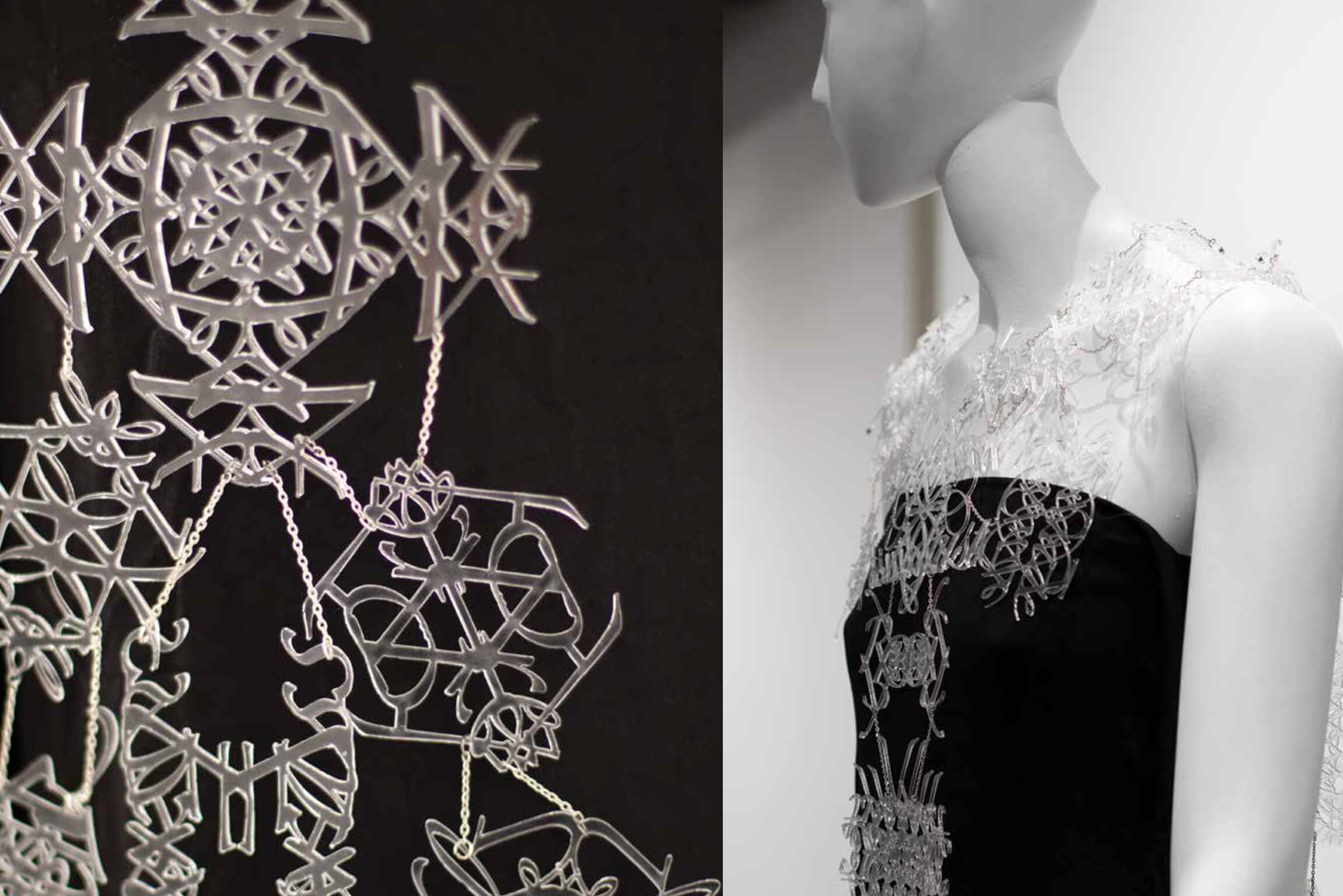This essay presents a portion of a body of work entitled Daemon & Saudade that was exhibited at the Art Gallery of Northumberland in Cobourg, Ontario from November 15th 2018 through January 13th 2019 (Figure 1). In this exhibition, embellished truths detail intimate accounts, while discrete representations of ephemeral events such as conversations and memories were translated into artworks. This research utilizes dress and semiotics as it comments on identity, and tells stories through images and wearable sculptures. Fashion is pervasive. It infiltrates and intersects with every aspect of life, and here, it is also used to speak through metaphors about loss and death.
In Daemon & Saudade, I engaged with the public through a non-textual form of communication: an art exhibit. Visual metaphors impart fragments of my stories, which are meant to connect with and prompt people to relate their own experiences about grief and loss on a personal level. Throughout the creation of the work, fugitive events and transient recollections were documented through processes such as journaling and photographing, before they fleetingly dissolve into gossamer-thin memories over time.
In Daemon & Saudade, I engaged with the public through a non-textual form of communication: an art exhibit. Visual metaphors impart fragments of my stories, which are meant to connect with and prompt people to relate their own experiences about grief and loss on a personal level. Throughout the creation of the work, fugitive events and transient recollections were documented through processes such as journaling and photographing, before they fleetingly dissolve into gossamer-thin memories over time.
My work is interdisciplinary and autobiographical, disclosing personal narratives that evolve from issues of identity, memory, and experiences shared with others. I sought to connect with a public that I would not physically meet, and through the work, ask them how my stories could intersect with their stories, how grief and loss affected them, and how close to the surface those memories remain. The query in making and exhibiting this body of work, was to ask the following:, could a connection be made to a community at large that had not considered grief and loss through fashion as a lens and vehicle? Collectively this practice explores emotion, grief, loss, and preservation through a series of photographic prints, sculptural garments, and jewellery. The work fostered a resonant experience, and that resonance was intended to provoke dialogue by stirring memories and emotions, creating an exchange that might be an inner or outer discourse with the viewer. Grief is intimate and highly personal, yet it is something we collectively experience. Using my narrative as an access point for discourse on the subject allowed the creation of work that speaks with a personal voice while at the same time remaining relatable to the public. The use of text on the didactic panel, in both the catalogue and descriptive labelling, actuates the material for viewers and provides access to content of the work.
The title of the exhibit, Daemon & Saudade, represents two distinct concepts. “daemon” refers to both an archaic spelling of the word demon, and indicates that something is going on behind the scenes; it is also associated with a computer program that runs in the background and is beyond the user’s control (Stevenson). Adapted and re-contextualized, the use of the word daemon in the title relates to the unknown. For example, we lost my father in five short weeks. We knew something wasn’t right. There was something else going on, of which we were not aware. Slowly, beneath detection, disease was growing inside him — a demon of sorts.
The second part of the title uses a Portuguese word, saudade. Some words are just missing from the English language — words that convey depth, meaning, and sentiment. “Saudade” is one of those words. It refers to the love that remains after someone is gone. Initially, this could be understood as when a loved one has passed. A broader interpretation of the subtlety of the word might include a different kind of grief: when a relationship has come to an end, for example. Saudade encompasses feelings and experiences, emptiness and absence, nostalgia, and melancholy. It is an emotional state that brings both sad and happy feelings together. Paired together, “daemon” and “saudade” communicate an intricate complexity of physical, emotional, and mental states.
The sentiments of personal grief and loss in this exhibition are heavily influenced by the painfully visceral work of Columbian artist, Doris Salcedo, whose artwork gives voice to victims of violence both personal and cultural. Salcedo’s work comments on loss and grief that is both collective and individual at the same time — a sense of loss that is palpable. In Untitled, a series of sculptures created in the 1990s, Salcedo juxtaposed hybrid domestic objects constructed of mismatched furniture filled with concrete. They are enduring, smothering, behemoth objects, where delicate articles of clothing and belongings rise to the surface of the concrete. In Atrabiliarios, Salcedo encased shoes in walls, visually filtering them through stretched animal fiber sutured to the drywall. They eerily speak of the quiet after death. In a video documenting Salcedo’s artist talk for her Retrospective exhibition in 2015 at the Solomon R. Guggenheim Museum in New York, she refers to her struggle representing contradictions such as “silence and utterance” (16:28–16:53) and a desire to create art that allows her to actualize the life experience of the victims of violence in a new way. Her work communicates grief on a grand scale using poetics to convey loss through detached emotion, and uses fashion as a point of connection with memory and the unknown subject. In the video, Salcedo specifically mentions “The memory of experience always vanishing” (Guggenheim Museum 25:28–25:40).



















